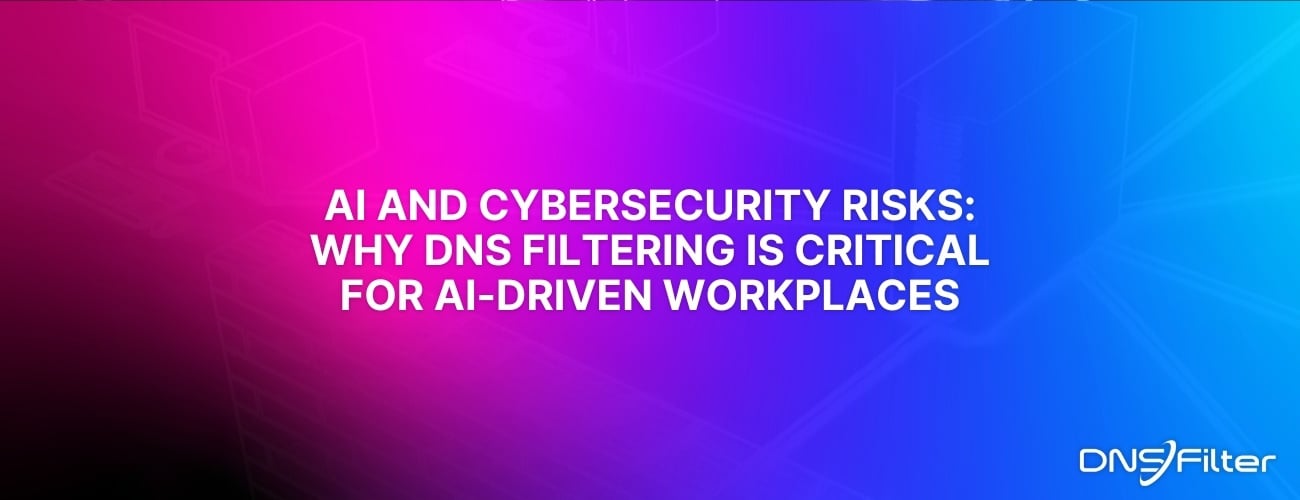Share this
Trends of Cybersquatting, Typosquatting, and Other Malicious Domains
by Kory Underdown on Feb 25, 2025 10:18:54 AM
The Growing Threat of Malicious Domains in Cybersecurity
As cybercriminals continue to evolve their tactics, domain-based attacks like cybersquatting, typosquatting, and other malicious domains have become a significant threat to businesses and individuals alike. These attacks are designed to exploit trust, impersonate brands, and mislead users into handing over sensitive information—often resulting in financial losses, data breaches, and reputational damage.
For cybersecurity professionals, technology leaders, and Managed Service Providers (MSPs), protecting against these threats is no longer optional—it’s a critical component of a modern security strategy. Attackers are using AI-powered automation to scale their domain fraud operations, making detection and prevention more complex than ever.
This article will provide a comprehensive look at cybersquatting, typosquatting, and other domain-based cyber threats, including:
- What are the latest cybersquatting and typosquatting techniques?
- How do malicious domains impact businesses and individuals?
- What role does DNS filtering play in stopping cybersquatting attacks?
- How can organizations protect their brand and data from domain-based threats?
With AI-driven domain generation and more sophisticated phishing techniques, these threats are rapidly growing. As we shared in 2025 Cybersecurity Predictions: Not Just AI, malicious domain abuse is expected to increase, with attackers exploiting new domain registration trends, expired domains, and brand impersonation tactics at an unprecedented scale.
Understanding these evolving threats—and implementing proactive security measures like DNS filtering—is essential for preventing financial losses, protecting brand reputation, and securing users from cyber fraud.
What is Cybersquatting? Definition and Key Differences
To effectively combat domain-based threats, it’s important to understand the three primary forms of malicious domain abuse:
|
Aspect |
Cybersquatting |
Typosquatting |
Malicious Domains |
|
Definition |
Registering domains similar to trademarks or brand names with bad faith intent |
Registering domains with common misspellings of popular websites |
Domains created specifically for malicious purposes |
|
Primary Goal |
Profit from a trademark’s goodwill or sell the domain to the rightful owner |
Capture traffic from users who mistype URLs |
Distribute malware, conduct phishing, or other cybercrimes |
|
Target |
Established brands and trademarks |
Popular websites and services |
Unsuspecting internet users |
|
Method |
Uses identical or confusingly similar domain names |
Exploits common typing errors |
Various techniques, including cybersquatting and typosquatting |
|
Examples |
brandname.com, brand-name.com |
goggle.com (instead of google.com) |
malware-distribution.com, phishing-site.com |
|
Legal Status |
Illegal under trademark laws |
Illegal but harder to prosecute |
Illegal and often subject to takedown requests |
|
Potential Harm |
Brand dilution, lost traffic |
Identity theft, malware infection |
Data theft, financial fraud, malware distribution |
|
Prevention |
Trademark registration, proactive domain monitoring, DNS filtering |
User education, browser security features, DNS filtering |
Security software, blocklists, user awareness, DNS filtering |
Cybersquatting Definition and Examples
Cybersquatting occurs when individuals or entities register domain names that are identical or confusingly similar to existing trademarks or brand names, intending to profit by reselling the domain or misleading users. ICANN regulations and the Anti-Cybersquatting Consumer Protection Act (ACPA) provide legal protections against these practices, but enforcement remains a challenge.
Real-World Cybersquatting Examples:
- Coca Cola Co. successfully sued an individual who registered cybersquatted domains, like drinkcoke.org, and used the sites to share charged messaging and opinions unrelated to the brands they were impersonating.
- Microsoft has been fighting back against cybersquatters who register deceptive domains using their brand name since 2006.
Typosquatting Definition and Examples
Typosquatting takes advantage of common typing errors made by users when entering a website address. Attackers register domains that closely resemble legitimate websites, hoping to trick visitors into believing they are on the real site. This guide to typosquatting outlines how attackers exploit brand trust.
Typosquatting Examples:
- goggle.com instead of google.com – Used in phishing campaigns.
- amaz0n.com instead of amazon.com – Redirects users to scam sites.
Malicious Domains and Their Role in Cybercrime
Unlike cybersquatting and typosquatting—where the goal is often monetary gain or brand deception—malicious domains are created explicitly to spread malware, steal credentials, or launch cyberattacks. These domains frequently appear in phishing emails, social engineering attacks, and malware distribution networks.
Emerging Trends in Cybersquatting and Typosquatting
Cybercriminals are constantly evolving their tactics, making it increasingly difficult to detect and prevent domain-based threats. Some of the latest trends include:
AI-Powered Domain Generation
Attackers now use machine learning algorithms to generate thousands of domain name variations within seconds, allowing them to bypass traditional security filters. These domains are used in automated phishing attacks, fake login pages, and brand impersonation scams.
Expired Domains and Brand Hijacking
Cybercriminals buy expired domain names that were previously owned by legitimate businesses, then repurpose them for malicious activity. These domains retain authority and credibility, making phishing attacks more effective and harder to detect.
Short-Lived Domains and Evasive Tactics
Many malicious domains are now registered, used, and abandoned within a few hours—often before security systems can detect them.
How Malicious Domains Impact Businesses and Individuals
The financial and reputational damage caused by cybersquatting, typosquatting, and malicious domains is significant.
Financial Losses from Fraudulent Transactions
- E-commerce businesses lose millions annually due to customers making purchases on fraudulent lookalike sites.
- Corporate phishing scams using typosquatting domains have led to multi-million-dollar wire fraud cases.
Brand Reputation Damage from Domain Abuse
- When malicious domains impersonate legitimate brands, customers lose trust.
- Examples of cybersquatting include fake customer support pages stealing personal data from unsuspecting users.
Increased Phishing, Malware, and Ransomware Attacks
- Malicious domains serve as launchpads for phishing campaigns and malware infections.
- Typosquatting sites deliver credential-stealing malware, targeting employees and customers alike.
Regulatory and Legal Risks for Failing to Act
- Companies that fail to monitor and take action against cybersquatting may face legal consequences under trademark and consumer protection laws.
The Role of DNS Filtering in Preventing Domain-Based Threats
As cybersquatting, typosquatting, and malicious domains continue to evolve, traditional security measures alone are no longer sufficient to protect businesses and individuals. DNS filtering plays a critical role in proactively blocking access to these threats before users ever encounter them.
How Does DNS Filtering Prevent Cybersquatting and Typosquatting?
DNS filtering operates as a first line of defense, preventing malicious domains from being accessed by blocking DNS resolution for known or suspicious domain names. By analyzing domain activity in real-time, AI-powered DNS security solutions like DNSFilter can detect and automatically block malicious domains before they cause harm.
Infographic: Attack Flow Diagram
|
Step |
Description & Example |
Impact on Users |
Defense Mechanism |
|
1. Domain Registration |
Attackers register fraudulent domains (goggle.com, brandname-support.com). |
Users visit fake sites. |
AI-powered DNS detects suspicious domains. |
|
2. Fake Website Setup |
Cybercriminals create phishing pages mimicking real brands. |
Users enter credentials or download malware. |
DNS filtering flags lookalike sites. |
|
3. User Clicks Malicious Link |
Victims access fake sites via search, email, or ads. |
Data theft, account compromise. |
URL scanning & DNS security block threats. |
|
4. Data Theft & Malware Delivery |
Stolen credentials sold; malware infects devices. |
Identity theft, ransomware, financial loss. |
Endpoint security & threat monitoring. |
|
5. DNS Filtering Protection |
AI-powered DNS filtering blocks access to malicious domains. |
Prevents cyberattacks before they happen. |
DNSFilter ensures proactive defense. |
How Does AI-Powered DNS Filtering Detect Malicious Domains?
Modern AI-driven DNS security detects newly registered malicious domains in the following ways:
- Behavioral Analysis: Identifies patterns in how a domain is registered, its associated IP addresses, and how it's being used.
- Reputation Scoring: Compares new domains to known malicious sites and assigns a risk score.
- Real-Time Blocklisting: Prevents access to domains used for phishing, malware, or impersonation attacks.
- DNS Encryption Protection: Blocks DNS tunneling attacks used for data exfiltration.
Example: A typosquatted version of a banking website might bypass traditional security measures, but AI-powered DNS filtering immediately detects it as fraudulent and blocks user access, preventing credential theft.
How Organizations Can Protect Against Domain-Based Threats
In addition to DNS filtering, businesses must take proactive measures to protect their digital assets and customers from domain-based attacks.
1. Secure Your Brand’s Domains to Prevent Cybersquatting
- Register multiple variations of your domain, including common misspellings and different TLDs (e.g., .net, .org, .co).
- Monitor for suspicious domain registrations that mimic your brand.
- Use legal mechanisms like UDRP (Uniform Domain-Name Dispute-Resolution Policy) to reclaim domains.
2. Implement DNS Security Solutions
- Deploy AI-driven DNS filtering to block cybersquatting and typosquatting domains before users encounter them.
- Use real-time threat intelligence to detect and prevent access to newly created fraudulent domains.
3. Train Employees and Customers on Domain-Based Threats
- Educate employees on phishing techniques and typosquatting risks.
- Encourage a company culture of sharing real examples of typosquatting and phishing encounters to increase awareness.
- Warn customers about scam domains impersonating your brand.
4. Strengthen Legal and Compliance Measures
- Work with legal teams to enforce cybersquatting laws and trademark protections.
- Partner with ICANN and regulatory bodies to take down fraudulent domains.
By combining brand protection, DNS security, legal enforcement, and employee education, organizations can create a multi-layered defense strategy against domain-based cyber threats.
Secure Your Business Against Cybersquatting and Malicious Domains
The rise of AI-driven cybersquatting, typosquatting, and malicious domain abuse requires a proactive, multi-layered security approach. DNS filtering, AI-powered threat detection, and brand monitoring are critical components of protecting businesses from financial loss, reputational damage, and cyber fraud. Don’t let cybercriminals take control of your brand’s digital identity—implement AI-driven DNS security and proactive brand protection strategies today.
Protect your business from cybersquatting, typosquatting, and domain-based threats. Try AI-powered DNS security today — sign up for a free trial!
Share this
 Artificial Intelligence in Cybersecurity
Artificial Intelligence in Cybersecurity
The term “artificial intelligence (AI)” was first coined in 1956. While progress stalled for many years, we can thank IBM for sparking real interest in AI as viable technology: First in 1997 when the computer Deep Blue defeated a chess champion and again in 2011 when Watson won Jeopardy!
 The Mind Games Behind Cyber Attacks
The Mind Games Behind Cyber Attacks
Hackers have long understood that the most sophisticated firewall is no match for a well-placed psychological trick. While many focus on the technical prowess of cybercriminals, the real magic often lies in their ability to manipulate human behavior. By exploiting our natural tendencies and cognitive biases, hackers can slip past even the most robust security systems. It's not just about cracking codes; it's about cracking the human psyche.
 AI and Cybersecurity Risks: Why DNS Filtering is Critical for AI-Driven Workplaces
AI and Cybersecurity Risks: Why DNS Filtering is Critical for AI-Driven Workplaces
Artificial intelligence is transforming business operations, automating everything from customer service to data analysis. But with these advancements come new security challenges. AI-driven cyber threats are becoming more sophisticated, enabling attackers to automate phishing campaigns, generate malware, and exfiltrate sensitive data at scale. Without proper safeguards, AI tools can unintentionally leak corporate secrets or connect to malicious ...


